In case you didn’t know, With the Woodruffs is our second blog. Our first site, masonfit.com, is a food blog that makes over $30,000 per month and will see around 10 million page views this year. We both work full time on the site and have the freedom to work on what we want from wherever we want. The blog has also allowed us to meet awesome people, work on interesting projects, and scratch our creative itch. Simply put, it is the bee’s knees.
Okay, the brag fest is over. There’s just no better way to show you how starting a blog could change your life. I remember reading Pinch of Yum’s income reports back in 2015 when they were making $30,000+ and being so inspired. Honestly, I never would’ve imagined we could reach that level. I still feel like I’m bad at a lot of things and just making it up as I go. But here we are.
That’s why I’m writing this post. I want to inspire you, but I also want to teach you how to do exactly what we do. I’ll cover the basics of setting up a blog from a technical standpoint, your content creation strategy, and promotion of that content to grow your audience.
One quick note before we dive in. There is a lot to blogging. I’m still learning as we go, and it’s important to not get overwhelmed when you’re starting out. Take it one step at a time and try to get a little better every day. Success can happen quickly in the blogging world, but it won’t happen overnight.
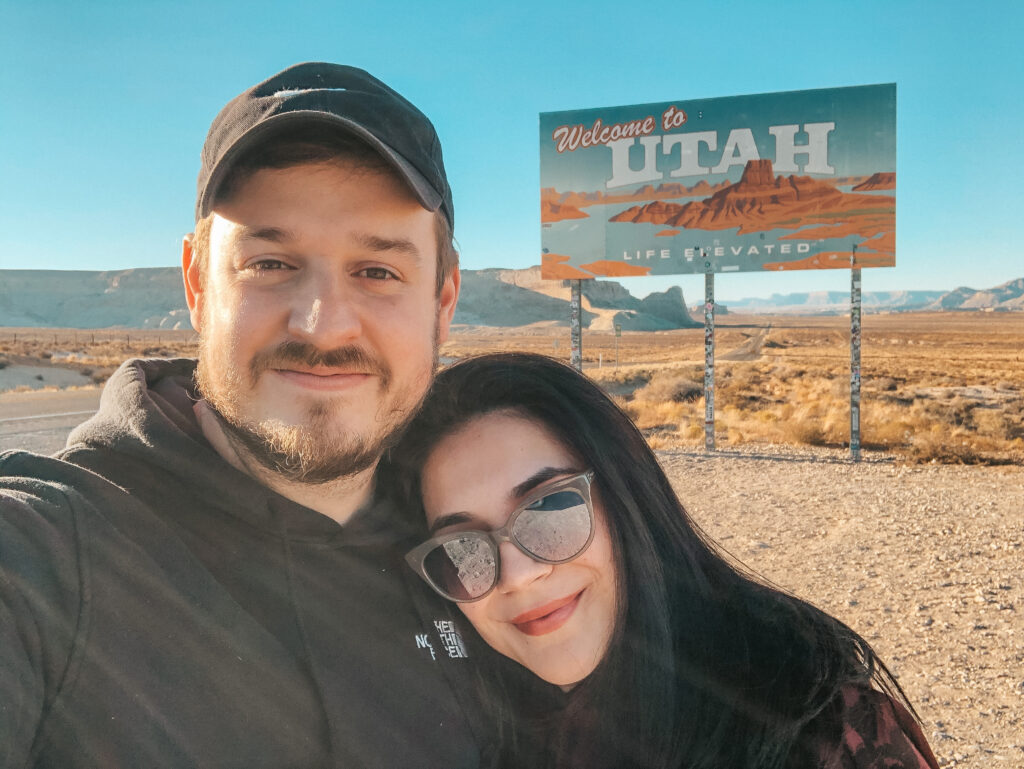
Our posts may contain affiliate links. As an Amazon Associate, we earn from qualified sales. Click here to read our full disclosure.
Creating Content
You won’t usually see creating content at the top of a guide to starting a blog. That’s because it’s the hardest part. Instead of spending time and money setting up a blog, I think it’s a good idea to see if you have what it takes to create content in the first place. If you breeze through 10 posts while having a good time and feel like you have plenty more to say, you might just be in business.
In addition to writing your first 10 posts, I would recommend brainstorming and creating a list of topic ideas. The longer the better. And as a bonus tip, think about how all the posts will intertwine and link together in the future, making your blog a complete resource center for the things you blog about.
And finally, I am not a planner, but I do set publishing expectations. Posting consistency matters, especially early on. Decide up front how much time you have to dedicate to your blog and set a realistic goal for how often you’ll publish a post. Then stick to it.
I’ve published 2-3 new posts per week over the past 3 years on our main site. Even after some post cleanup from the early days, the site has around 400 posts bringing in 750,000+ pageviews a month.
What is Site Structure?
While don’t need to create a massive content library before launch, there are benefits to having a general idea of what your site structure will look like. And by site structure I mean the main categories and any subcategories. You can always adjust down the road, but this is definitely worth some thought and planning on the front end. Choose 4-6 main categories and publish a few posts under each category before launch.
When we started this new blog, we chose the following categories: online business, recipes, lifestyle, travel, and Best of Texas
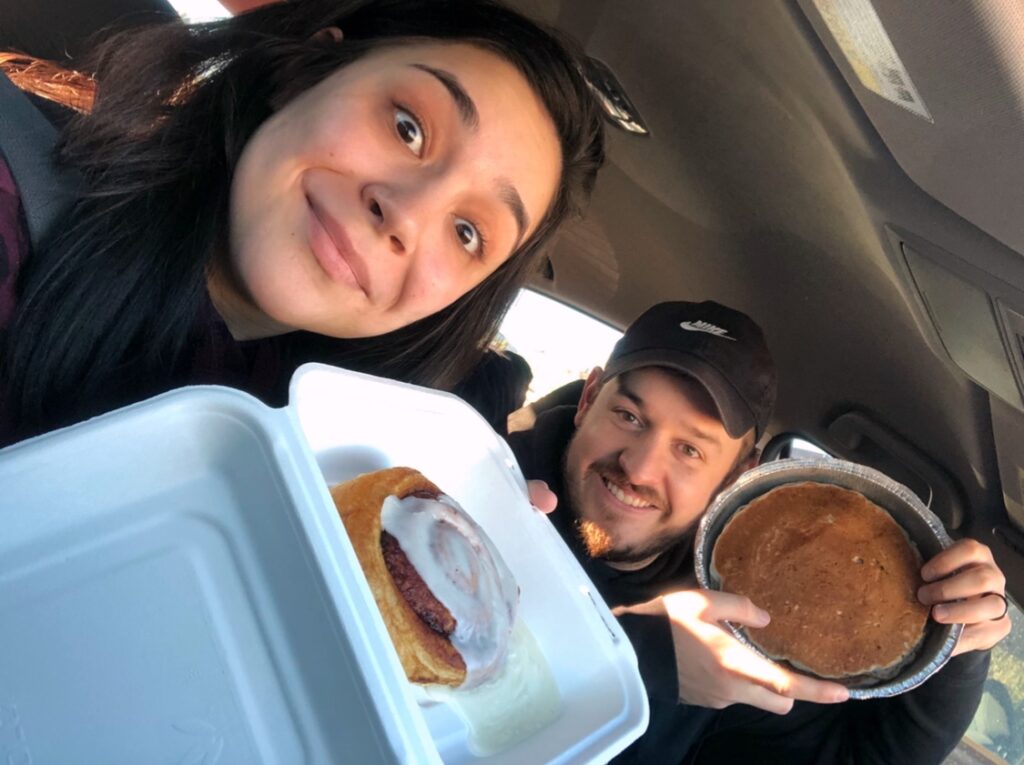
We launched with 2 posts in each category for a total of 10 posts. I would’ve liked more, but things are busy around here and that’s a good enough start to keep the momentum going.
10/21 Update: We’re now up to 54 posts on With the Woodruffs. That puts us on track to publish roughly 1 post per week over the past year. With some posts like our favorite Austin restaurants list being monster posts that receive continual updates, we’re pleased with that pace.
Personal Blogs vs Niche Sites
It’s worth mentioning, we’re talking more about personal blogs than niche blogs here. If you’re unfamiliar with niche blogs, those will be blogs that focus on, you guessed it, one very specific niche. Our main site is a food blog which you might think is a niche site, but a niche site would be more along the lines of one of my favorite resources, Chili Pepper Madness. Other examples in the food space might be a site that publishes exclusively air fryer or Traeger Grill recipes.
Unless you’re a bonafide expert on a topic, I wouldn’t start with a niche site. They take some expertise when it comes to SEO and affiliate marketing, and they tend to be fairly competitive. Save that for later when you’re an experienced blogger and just focus on publishing content that you’re super interested in right now. You may discover early on that you are only interested in one particular niche, but most people are all over the place with their interests.
Building Your Blog
Once you feel good about your content and commitment to a production schedule, it’s time to start your blog and get your content published. I’ve done my best to give you specific steps and help with some of the technical bits, but this process may change depending on which services you go with. Here are the 4 things you’ll need to do:
- Choose and buy a domain.
- Sign up for web hosting.
- Install WordPress.
- Choose a WordPress theme/design for your blog.
I’ll cover each step below in more detail but if you have a question or get stuck, I’d be happy to help!
Choosing a Domain
All the talk about niches and areas of expertise is a great transition into choosing the name of your blog. With a niche site, you’ll ideally want the name of your niche or related keywords in your domain. Using Mike’s Chili Pepper Madness example from above, you (and Google) know exactly what his site is about. But since we’re talking primarily about personal blogs, choosing the perfectly optimized domain name is less important.
Some will even tell you a domain name doesn’t matter at all since Google is so smart these days. I’m somewhere in the middle. Having a great domain name can be great for brand awareness. But not many people have a brand fully worked out when starting a blog. And getting started is the most important step here. So if choosing a domain name is holding you up in a major way, just choose something and get going.
These are things I’d consider when choosing a domain name:
- Make it short, easy to spell, and easy to remember. Don’t get too cute with internet jargon.
- If you have to decide between the perfect domain with a non .com extension, choose another domain with a .com extension. The exception here might be using your full name with a .net or .org extension. (More on searching for domain availability and purchasing a domain in a minute.)
- Choose something and stick to it. Age of domain and authority will help tremendously down the road if you decide to get serious about blogging.
- And just to reiterate, the domain name isn’t that important. I’m not a fan of masonfit.com, but it’s not stifled my blogging success as far as I can tell.
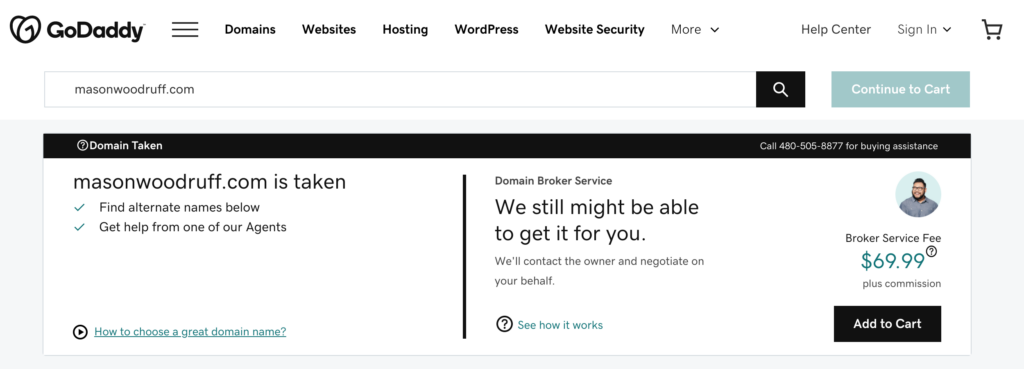
And while we’re on the topic, it’s never a bad idea to see if your name is available. Don’t worry, I snagged mine a few years ago after the previous owner forgot to renew! If you’re having trouble choosing a domain name, your name would be perfect for a personal blog.
WordPress vs SquareSpace vs Wix vs (Insert Blog Platform)
I could tell you about how all the non-WordPress platforms are terrible for SEO and how most serious bloggers always end up switching to WordPress, but I’ll just say that WordPress is what I’ve always used. So that’s what I recommend. It’s pretty much the gold standard for blogging and you’ll be setting yourself up for long term success by starting on WordPress.
I’ll also add that if you blog on one of the free platforms, you won’t actually own your blog. If something happens to that platform, your blog could disappear overnight.
IMPORTANT BUT SLIGHTLY CONFUSING NOTE: So there’s a difference between WordPress.com and WordPress.org. The former is a free blogging platform where you can start a blog like withthewoodruffs.WordPress.com while the latter is an open source software that allows you to blog on your own domain like masonfit.com. If that’s confusing just focus on the takeaway—don’t use WordPress.com or other free blogging platform. We’re here to blog for real, remember?
Okay, back to domain names.
Buying a Domain
I would use one of the big providers like GoDaddy or 1&1 to buy and register your domain. But you will not want to use them for hosting (more on that in a minute). And depending on who you use for hosting (more on that in a minute as well), you may be able to buy and register a domain directly with them. The huge providers mentioned above will simply have the best pricing and deals for buying domain(s).
It’s also worth mentioning, if you’re not all that tech savvy, a good hosting company will be able to use your login credentials from a domain registrar to transfer all the info they need to get you up and running. All you’ll need to do is point your domain name serves (DNS) to your web hosting service but if that sounds like French, let your hosting company help!
What is Web Hosting?
If you think of your domain name as a cell phone, then your web hosting is your cell phone carrier (Verizon, AT&T, etc.). Web hosting is the service that actually delivers all the information that’s on your website to users. That might sound complicated, but a good host has plenty of resources and people to help you get everything set up. And once it’s set up, you’ll never really need to know much else. As long as you use a good hosting company, that is.
For our web hosting, I use BigScoots managed WordPress hosting ( and can’t recommend them highly enough. Our main blog has seen nearly 10M pageviews in 2020 and our basic starter plan with BigScoots has supported all that traffic like a champ. Not to mention, their support makes Chick-Fil-A look like Chump-Fil-A. They respond within minutes and have helped me with way more than they should. I’ve seriously emailed them to tell them I don’t pay enough.
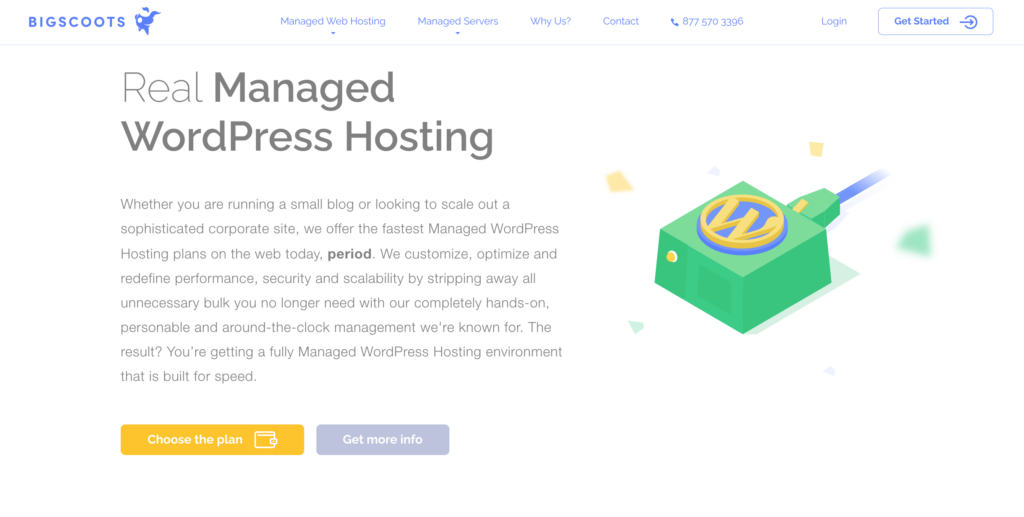
BigScoots also has a great guide on their blog on installing and setting up WordPress, which covers everything from buying a domain to getting your site up and running.
If you’ve ever read a post on how to start a blog before, you’ve probably come across the recommendation to use BlueHost, and that’s because they pay excellent commissions and are very low cost. With that low cost, however, comes very low quality. They’re known for having tons of down time (site crashes), terrible customer service, and poor performance (slow sites).
Invest the money up front to set your new blog up for success in the long run, and you’ll save yourself a headache down the road. Trust me, I started out with BlueHost and HostGator on two sites.
Other hosting companies who come highly recommended from some of my blogging friends include Agathon, Siteground, and WPOPT.
Designing Your Blog
Similar to choosing a domain name, this is a part of starting a blog that plenty of people get hung up on, myself included. Just know that you will redesign your site multiple times over the course of its life. So don’t stress about the perfect design early on. Just get the thing running and get to work on content.
To start designing your site, you’ll need to log in to your BigScoots portal and install WordPress to your domain. They’ll take care of this for you. Just click the button and wait for them to finish. Once it’s up and running, you’ll create your WordPress admin login and access your dashboard. From here you can install plugins (tools for your blog), add and edit posts, and choose a theme to design your blog.
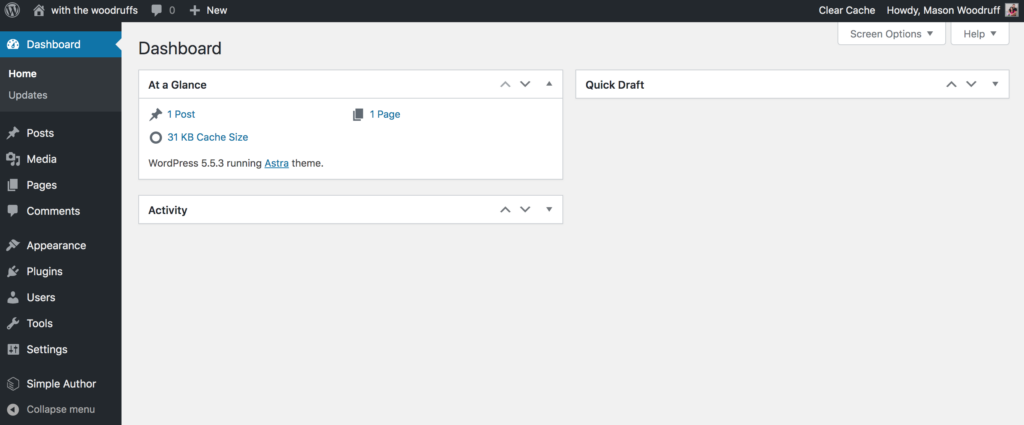
There are tons of free themes and some premium options as well. I’ve always tested free themes and upgraded to the Pro versions if I needed added features. There’s plenty of customization you can do to things like text spacing, font styles, and all that jazz with a little Google searching. That’s one of the cool things about using WordPress. Plenty of others are using the same themes and plugins so you’ll be able to find troubleshooting tips.
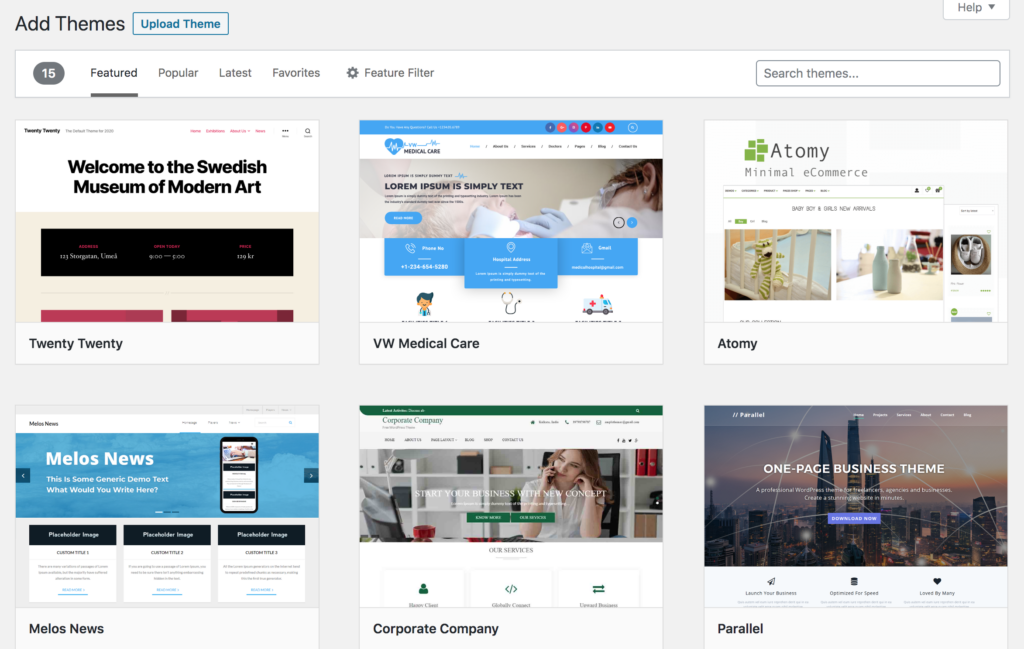
Here are a few more things to consider when designing your blog:
- Check your theme’s settings to make sure you’re not using dates in your URLs. You want the post title in your URL and nothing else.
- Keep the plugins to a minimum. Learn what everything does and decide whether you need it or not.
- Make your early site design as reader friendly as possible. No ads, no pop-ups, no intrusive buttons or sidebars… you get the point. Once you build up your content library and traffic, you can add those things in along the way.
10/21 Update: Both of our sites currently run Mediavine’s Trellis theme with the Wisteria child theme. It’s built for speed and optimized for ad delivery, which is our primary revenue stream as you’ll read about below.
What’s Next?
So you’ve published the content you created on your brand new blog. Now what? It’s time to get eyeballs on your content and start building an audience.
This part is difficult and requires some patience. In the beginning, nobody is going to care. Your friends and family will pretend, but they’re just being nice. That’s cool, you want people who are really interested anyway!
It’s important in this step to not get discouraged by the crickets and continue publishing new content. What’s cool about SEO and organic traffic (more on this in a second) is that you don’t really need an existing audience to drive large amounts of traffic and stack lots of dough. But even that takes lots of content creation and patience. Keep your head up and keep creating.
Generating Traffic and Making Money from Your Blog
There are lots of ways to drive traffic to your blog, but our breakdown on masonfit.com looks a little something like this:
- 55% from social media (about 80% from Pinterest and 20% from Instagram/Facebook)
- 35% organic search (primarily Google search)
- 10% direct or referral traffic (readers clicked a link to our blog from somewhere else)
I’ll touch on all the potential sources below and give a few tips for each one. But I’d like to point out that our big focus for the past year and half has been improving the ratio of organic search visitors to social media visitors. Organic search is king when it comes to long term traffic success and focusing on things like SEO early will be a big help in speeding up your success. Which brings us to the first traffic source tip section.
Start Learning SEO Best Practices (Slowly)
SEO, or search engine optimization, is essentially a method for formatting your blog posts to rank well on search engines like Google. The beauty of organic traffic is that it takes no actual promotion and can snowball over time. This is just back of the napkin math, but we made around $10,000 from our organic traffic last month alone.
The world of SEO is ever changing and there’s tons to learn, but you can get the basics down rather quickly. While your focus should be primarily on creating the best content you can, taking some time to learn said basics will save you a lot of work down the road. I’m constantly having to go back and update old posts I published before I had any SEO knowledge.
One of the easiest first steps would be to start with a simple plugin like Yoast or Rank Math which serve as guides as you write posts in WordPress. Their suggestions aren’t the end all be all, but they’re a great starting point for learning the basics of on-page SEO.
Then begin some passive learning via sources like the Theory of Content podcast, the Ahrefs blog and YouTube, and SEO experts like Glen Allsopp and Brian Dean. Similar to everything else I’ve mentioned in this post, don’t get overwhelmed. Start slow and learn as you go.
This is our biggest source of traffic on masonfit.com. Certain niches will do better on Pinterest, but that doesn’t mean you should ignore Pinterest if you have a non-Pinteresty blog. Their platform is still growing and well designed pins with original, high quality photos will find an audience.
Other than designing and posting pins, the best practices for using Pinterest seem to change all the time. We currently post 3-5 new pins per day to our own boards that are set up like a recipe index, but that’s been much different in the past. Your pinning frequency will also depend on the size of your content library. Don’t repin the same piece of content 30 times a month.
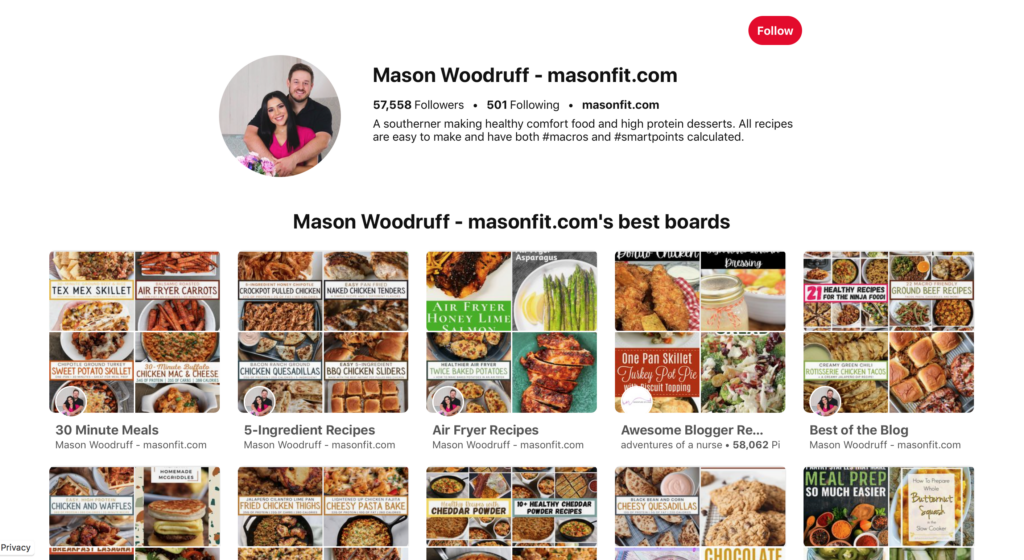
Pay attention to the info Pinterest puts out and maybe join a Facebook group or two (like the Simple Pin Pinterest Strategy group) for learning about Pinterest.
10/21 Update: Bloggers, including us, are really struggling to get traction on new content via Pinterest. They seem to be placing a big emphasis on their “story pins” which aren’t valuable for generating traffic at this point. This has slowed our timeline of getting With the Woodruffs beyond Mediavine’s traffic threshold, hence the lack of ads here. I’ll update this post as we see how things pan out with Pinterest.
The ‘gram is tricky, and it seems to only get trickier with time. When I started working on masonfit.com full time in late 2017, I went all in on growing an Instagram following. This meant posting 3x per day, answering every DM, responding to every comment, posting multiple stories daily, and spending 4+ hours each day on the platform. That sounds crazy, right?
Well, it paid off. Instagram is still our largest social following. At the time of this writing, my Instagram has 182,000 followers. That following has undoubtedly led to success in other areas like Pinterest growth and organic traffic based on brand awareness. I’ve also pointed people on Instagram to my Facebook group and email list for audience diversification.
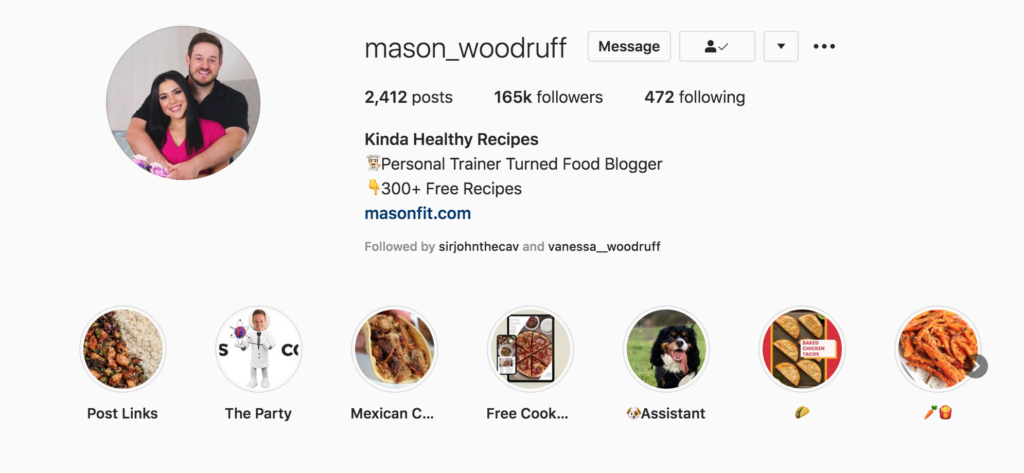
All that said, I spend way less time on Instagram than I used to, and my growth on IG has come to a screeching halt this year. Organic reach is on the decline and it seems less vital to blogging success with each day.
If you’re just starting out, I’d say this. Definitely start an Instagram and spend some time there. But prioritize content creation and SEO for organic traffic first. Use Instagram to connect with other bloggers in your niche, especially with similar sized audiences. You can help each other out and grow together.
And if you decide you want to focus on this area, check out my post on how to get Instagram followers.
Email List
This will be hypocritical, since we’re terrible at email marketing, but your email list is one of the biggest assets you can build. You own your list which means you don’t have to worry about algorithm changes, site crashes, or anything like that. It’s a direct line of communication with your audience.
Start an email list as soon as you can to start collecting email addresses from your readers. If you can get 1,000 people on your list, you can probably bank on getting 250-500 visitors to your blog every time you send an email.
Which, by the way, you should totally sign up for our new email list for With the Woodruffs below!
When it comes to email service providers, there are lots of options, and I’ve used a handful of them. When starting With the Woodruffs, I went with ConvertKit. I love their simplicity and user friendliness. We don’t get too fancy with automations or sales funnels, so reducing friction of creating sign up forms and writing emails was key in our decision.
If you decide to go with ConvertKit, you can use our affiliate link to support the rebellion.
Facebook Group
One of the best decisions we ever made was to create a Facebook group. We have more than 17,000 group members and a pretty high level of engagement. There are posts about all kinds of topics surrounding healthy food, cooking, and sharing of our content organically. We moderate new members but not posts, and the group manages itself really well.
This will be easier to grow once you have an existing audience. You probably won’t want to start here unless you’re resilient and okay with hearing crickets in the early days.
Twitter, LinkedIn, etc.
If you’re going to blog about a topic like finance, business, or something along those lines, you’ll probably want to be active on these platforms. Publish content where your potential audience hangs out.
YouTube
Video is only getting bigger from here. If you have the personality to be on camera, start making videos ASAP. Repurpose content from your blog to make videos, and repurpose original videos to make blog posts out of them.
Monetizing and Making Money Blogging
If you’ve ever watched The Social Network or know about this history of Facebook, Mark Zuckerberg was onto something with his reluctance to advertise. Most people monetize too soon, and it’s at the cost of their users. While I know you’re ready to start stacking fat stacks, always ask yourself if your monetization is coming at the cost of building an audience and finding your true fans.
When you’re ready to monetize and make some dough, here are the ways we do it:
Advertising
Our primary revenue source on the main site is display advertising. We use Mediavine for full service ad management, which means we don’t touch a thing. Mediavine and most of the larger ad networks have minimum traffic thresholds before you can apply to be a publisher, and that’s a good thing. While you can start throwing up your own Adsense banners right out of the gate, you won’t make much. Keep the user in mind and play the long game.

It’s also worth mentioning, not every blog will be a great fit for advertising. If you plan to blog about adult content or anything that advertisers might want to shy away from, your earning potential from ads might be limited. On the bright side, however, your earning potential from other sources in this section may be much higher.
Side note: You can find some great content about SEO and other blogging tips on the Mediavine blog.
Affiliate Sales
You’re probably familiar with affiliate sales at this point. This is where you recommend and link to products you use and (hopefully) love. If a reader purchases, you get a small commission.
A few examples of affiliate marketing in our content might be our Amazon storefront for kitchen equipment and ingredients, BigScoots link for web hosting, and 15% PEScience discount code ‘mason’ for protein powder.
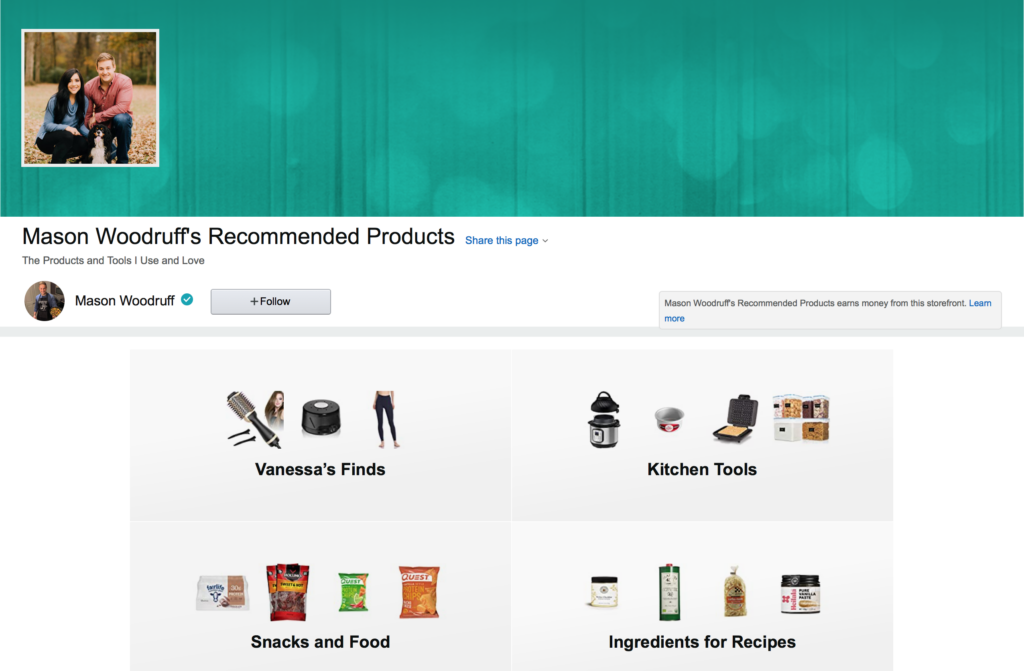
Some bloggers make a beaucoup of bucks with affiliate marketing, but it’s never been a huge percentage of revenue for us. Though depending on your niche and blogging style, you may want to dive head first into affiliate sales.
Subscriptions & Memberships
This won’t be much of an option right out of the gate, but is a good goal down the road once you’ve established some authority. Think: paid newsletters, membership sites for exclusive content, and things like our Patreon providing early access and supporter bonuses.
Your Own Products
Depending on your niche, you could make courses or eBooks, training programs, cookbooks, or physical goods. Your affiliate sales will give you a good idea of what your audience will buy from you.
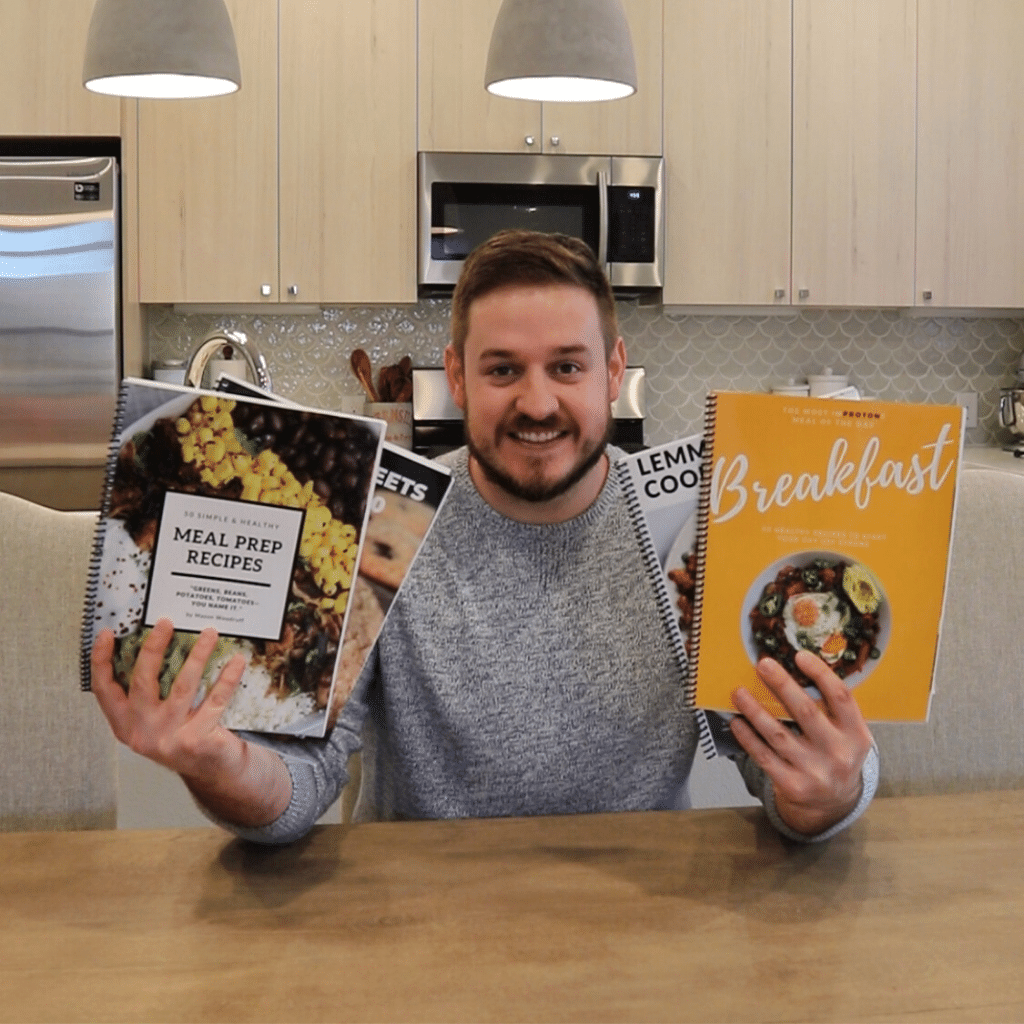
Services
If your blog is tied to your expertise, you could sell your services via your blog. When I first started masonfit.com, it was primarily to sell online personal training and land freelance writing gigs. This is a great early revenue model, albeit a non-passive source (read: trading time for money). Eventually you’ll want to bundle your expertise into a product if possible.
A few more examples I’ve seen in the blogging space include VAs and virtual assistants, food photographers and videographers, Pinterest and social media managers/consultants, and designers. If you’re coming into blogging with skills or develop skills that other bloggers could benefit from, it’s a rather easy sell once you have the proof on your blog.
Sponsored Content
As your audience grows, you’ll have opportunities to make content specifically for other brands. This is my least favorite revenue source, hence its position on the list. I’m not a fan of the back and forth on negotiating deals, editing content, and making sure I’m following all FTC guidelines at every single step.
I’ve yet to do a sponsored content deal where I walked away thinking it was the worth the time and headache. I also undersell myself like it’s going out of style, so take my advice on this revenue source with a quarter cup of salt!
It’s Unlimited
That’s just the tip of the iceberg when it comes to making money from a blog. We like to keep things as simple as possible and would love to avoid hiring and managing people at all costs. Once you have an audience (which you’ll build through creating content), the world is your oyster.
Wrapping Up
Whew! I think that covers it. If you made it this far, you’re destined for blog greatness. I can feel it. In case you’re a bullet point thinker like me, here are your key takeaways:
- Content is king. Create good content and commit to regularly publishing lots of it.
- Buy your domain and start with good web hosting. Install WordPress on your new domain via your host. Choose a simple theme and don’t spend too much time on designing your blog.
- Spread the word about your content via social media. It’s going to feel like you’re annoying people. You’re not. They’re probably not even listening. And that’s cool. They’ll come around. Don’t get discouraged.
- Spending time learning the basics of SEO in the beginning will save you time in the long run. You also won’t feel annoying because organic traffic requires zero self promotion on your end.
- Get a little better every day and don’t plan on your blog being a big success for quite some time. It’s a slow burn but almost always ends up looking like a hockey stick graph for people that stick with it.
Also, there’s a pretty high chance I missed a few things in the post. Or you may want to hear more about a specific section. Whatever the case, drop a comment below and I’d be happy to help.
Otherwise, good luck with your new blog. I can’t wait to read it!

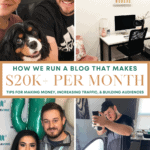
Christa
Tuesday 11th of May 2021
This article was extremely helpful and I love your honesty and different take on certain things! Thank you! I’m getting ready to start a blog since quitting my job to stay home with my daughter. I’m hoping to turn it in to at least partial income replacement so I never have to go back! I’ve written 10 posts with ease so far and I think I nailed down my name!
One question, do you recommend (or is it necessary) to get an LLC when building a blog in to a brand?
Mason Woodruff
Tuesday 11th of May 2021
Sounds like you're on the right track. Good luck with the new site! This isn't legal advice, but I'd say it's up to you. We're typically overly cautious and operate under an LLC with business insurance and the works. If you have rock solid disclaimers, privacy policies, etc. you're probably good in the early days. But these are interesting and litigious times.
Caleigh
Friday 9th of April 2021
Great! Thanks so much for the helpful info! I’ll be sure to check out that article 😊
Caleigh
Thursday 8th of April 2021
Hey there! I did have a question about advertising. How do you get advertisements to be posted on your blog page and how do you collect the revenue from that? That’s the only part where I’m like how does that work?
Mason Woodruff
Thursday 8th of April 2021
Hey Caleigh, the ad network we mentioned, Mediavine, handles everything for us. They take care of ad bidding, placement, delivery, and everything in between. We take a percentage of advertising revenue and collect at the beginning of every month. Mediavine has a sliding scale for revenue share based on your time with the network and total ad impressions. Meaning, the longer you're a Mediavine publisher and the more traffic your site gets, the higher percentage of revenue you take home (up to 85% I believe). If you want to get into the nitty gritty, they have a post on how blog ads work you can check out.
Caleigh
Tuesday 6th of April 2021
This was super helpful! Thanks. Would love to read more about this topic! I love to write and would love to start something one day.
Josh M
Friday 19th of March 2021
Yes, please! I really like this post, y’all.
Mason Woodruff
Friday 19th of March 2021
Thanks, Josh! Good luck with your new coaching venture. Let us know if there's anything we can do to help.